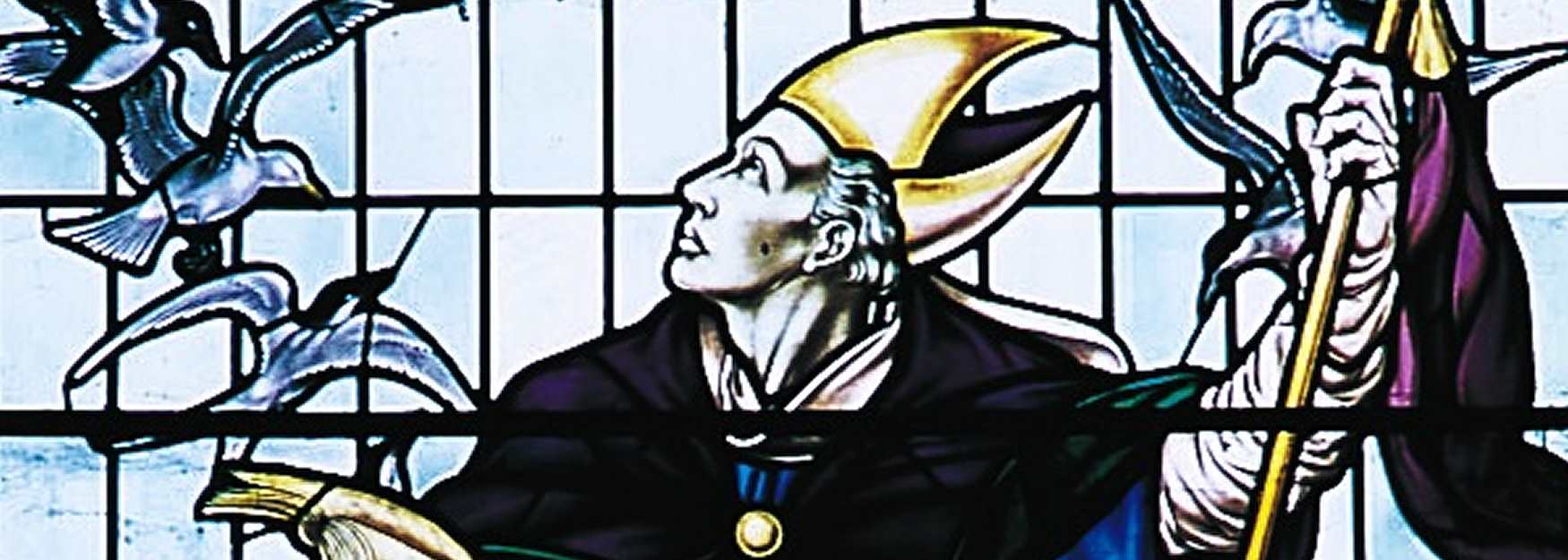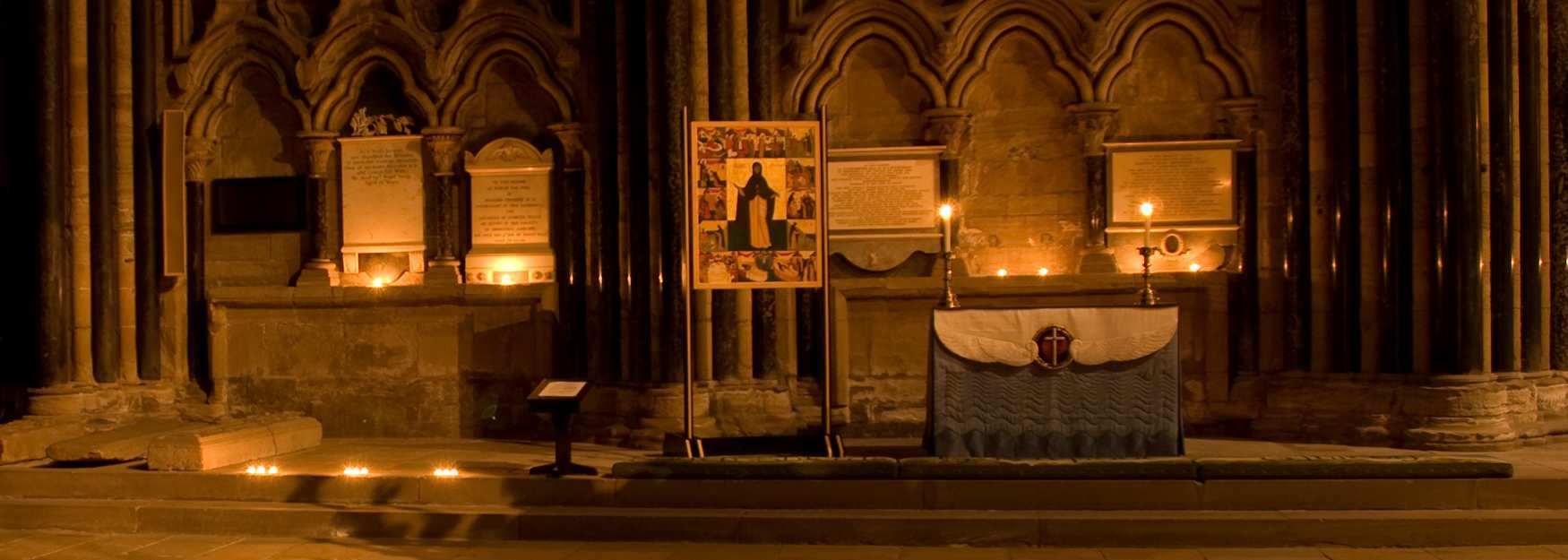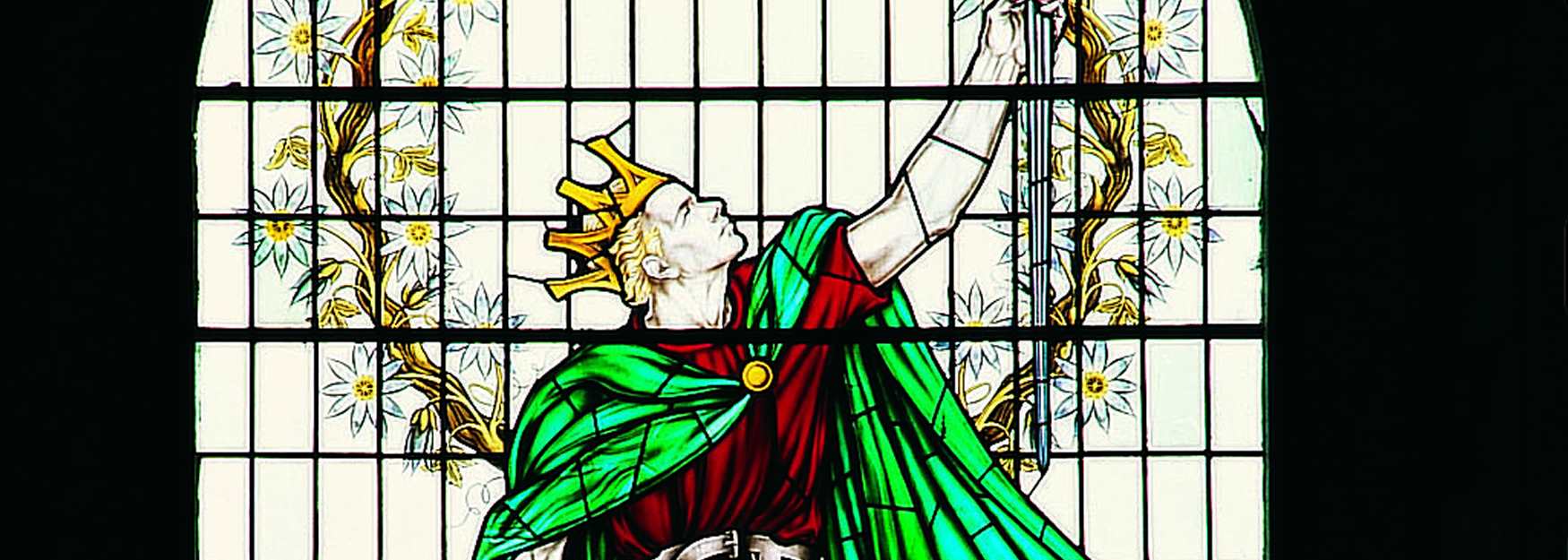Stories
ACCA
Acca lived in the age of Bede. For thirteen years a faithful friend of St. Wilfrid of Ripon, Acca accompanied him on his travels around Europe. Wilfrid nominated Acca to succeed him as Abbot and Bishop of Hexham. Acca was sensitive to beauty and the arts, and a fine singer. While not above political intrigue, Acca was a scholarly man, who encouraged these gifts in others; he was a close friend of Bede, who said of Acca’s library that it was 'large and most noble.' He died on 20th October 740 and was buried at Hexham Abbey, where two large, decorated stone crosses survive and can still be seen today.
ST AELRIC and ST GODRIC – Wolsingham
The Durham Dales are a very long way from the deserts of Egypt where, in the 3rd century AD, Christian hermits lived lives of deep faith whilst enduring gruelling hardship. But Wolsingham did witness the life of two individuals who chose a style of monasticism which traced its origins to those original Desert Fathers.
Cenobitic monasticism (“life lived in common”) stresses community life but one which is governed by a Rule. Benedict of Nursia (d.547AD) formulated one of the most famous Rules, based on humanity and moderation. This Rule governed medieval Durham’s monastic community.
But in keeping with the early Desert Fathers, Saints Aelric (d.1107) and Godric (d.1170) followed Eremitic monasticism placing great emphasis on leading a contemplative, solitary life of self-discipline and denial. It was at Wolsingham that Godric underwent his eremitical training learning from the older and more experienced Aelric.
Visit their Holy Well at Wolsingham to discover more.
ÆTHELWEALD
Æthelweald was the ninth bishop of Lindisfarne, and should not be confused with Æthelwald of Farne. Born around 670, he was already a novice at Lindisfarne when Cuthbert became bishop. He attended Cuthbert on some of his missionary journeys, and witnessed at least one of his miracles. He became prior and then abbot at Melrose before returning to Lindisfarne, to be bishop in succession to Eadfrith – the artist and calligrapher of the Lindisfarne Gospels – and gave these books their first binding. A large standing cross with his name on it survived to be taken from Lindisfarne to Durham.
AIDAN
Aidan, born in Ireland, became a monk at Iona and was sent to preach the Gospel in England at the invitation of Oswald, King of Northumbria. Oswald had grown up in exile on Iona, educated by the monks there, and requested their presence after winning back his kingdom in 633. Aidan and twelve others established the monastery on Lindisfarne in 635, which became the centre of missionary activity in the north of England, a valuable centre of learning and training. Bede described Aidan as "a man of remarkable gentleness, goodness and moderation, zealous for God".
Aidan's only method as a missionary was to walk the lanes, talking to all the people he met to interest them in the faith if he could. Aidan also made sure that it was possible in Northumbria for women to become nuns if they so wished, one of whom he encouraged was Hilda, later Abbess of Hartlepool and Whitby. Aidan died at Bamburgh on 31st August 651.
ÆLFFLÆD
Ælfflæd was born in 653, the youngest daughter of King Oswiu of Northumbria and St. Enflæd. Oswiu vowed her to the service of God in thanks for victory over the pagan Mercians in 655. Ælfflæd was sent – with a large dowry – to Hilda, her second cousin, then living at Hartlepool. Two years later, Hilda founded the famous double monastery of Whitby out of this wealth. Ælfflæd lived at Whitby for sixty years, a teacher of holiness and famous for her surgical skill. She succeeded Hilda, and her mother Eanflæd, as abbess in 680, assisted by the retired St. Trumwine. Once, when seriously ill, Ælfflæd and others were cured by the girdle of St. Cuthbert which he sent to her. Ælfflæd worked a winding-sheet for Cuthbert in return and sent it to him, in which he was buried.
Archbishop Theodore asked for her intercession with St. Wilfrid when he was recalled from exile by her brother, King Aldfrith of Northumbria. Wilfrid was exiled a second time and it was Ælfflæd who effected a reconciliation. She outlived both Wilfrid and Cuthbert and was present at the latter’s ‘elevation’ in 698. She died at Whitby on 8th February 714.
BEDE THE VENERABLE
Bede was born by the Tyne in 673. Being poor but clever, he was sent aged seven for an education at the newly founded Wearmouth monastery. Soon after, he went to the twin monastery at Jarrow, where he stayed as a monk until his death on 27th May 735. In his own words: "I have devoted my energies to the study of the Scriptures, observing monastic discipline and singing daily the services of the church; study, teaching and writing have always been my delight."
St. Boniface called Bede "a light of the church, lit by the Holy Spirit." He is one of the Church's greatest historians – his most famous book the 'History of the English Church and People' is the fullest available record of those times. He did not travel beyond Northumbria, but mastered Latin, Greek and Hebrew and had a good knowledge of the classical scholars and early church fathers. He also wrote on natural history, poetry, Biblical translation and exposition of the scriptures and three Latin hymns. In the 11th century Alfred Westow, sacrist of Durham Cathedral, moved Bede’s bones from Jarrow to Durham – no little controversy. His remains are there, enshrined in the Galilee Chapel of Durham Cathedral.
BENEDICT BISCOP
Biscop Baducing was born to noble parents in Northumbria in 628. He served as a warrior in the court of Oswiu, King of Northumbria, but at twenty-five he went on pilgrimage to Rome. He did not return to Northumbria until 672, having stopped at Lerins Abbey off the South Coast of France, where he became a Benedictine monk, hence the name ‘Benedict’. When he did return to the North he founded the dual monastery of St. Peter at Monkwearmouth, Sunderland, and St. Paul at Jarrow.
Returning from further pilgrimages to Rome, he instructed the monks in singing Gregorian Plain Chant from Rome and introduced stone church building and stained glass from the continent, much to local amazement. He also brought cart-loads of books to form perhaps the best monastic library in England. We have all benefitted from this love and learning – ten years before Biscop died, a seven-year-old boy named Bede joined his monastery at Jarrow. Benedict died on the 12th January 689, surrounded by his monks and exhorting them to the end.
JOHN OF BEVERLEY
John of Beverley, pupil of St. Hild, was the one who ordained Bede as both deacon and priest. We don’t know when or where he was born, but he attended the school of Canterbury and, after studying also with Hild, he succeeded St. Eata in 687 as bishop of Hexham. He became bishop of York in 705. Bede attributes to him miracles of healing: helping a dumb boy to speak, curing the swelling of someone’s arm, a noblewoman’s health and restoring one of his own priests who fell while disobediently racing his horse. He was a compassionate, sympathetic man, a man of prayer who became popular throughout the Middle Ages.
TRUMWINE
Trumwine ('Tumma' to his friends) was a contemporary and friend of St. Cuthbert. He, along with King Ecgfrith of Northumbria, carried the unwelcome news to Cuthbert of his election as a bishop; much pleading was necessary to convince Cuthbert to leave his hermit’s life on Inner Farne, to come and be bishop instead. Later, when Ecgfrith expanded north into Pictland beyond the Firth of Forth, Trumwine became bishop there, but not for long. With Ecgfrith’s defeat Trumwine and his monks fled and dispersed, so Trumwine ended up at Whitby with Ælflæd, Ecgfrith’s sister and St. Hild's successor. There he lived simply, with good works, and died c.704. Though not so well known, he likely knew all the major saints of Northumbria's golden age.
BOISIL
As prior of Melrose, under Abbot Eata, Boisil's reputation for holiness convinced the seventeen-year-old Cuthbert to choose Melrose, following his vision. Boisil saw Cuthbert approaching the monastery, immediately recognising his spiritual potential, and became the boy’s teacher and friend. In about 661 Cuthbert and Boisil both caught the plague; Cuthbert recovered, Boisil did not. Boisil prophesied Cuthbert’s ordination as a bishop; a saying that haunted Cuthbert until it finally came true.
Another monk, Egbert, later credited a heavenly vision of Boisil for dissuading him from an ill-planned missionary journey to the Germans. Boisil remained well respected – St. Boswell's, near Melrose, is named after him. As a fine teacher, those whom he influenced kept his memory alive.
EADBERHT
Eadberht became bishop of Lindisfarne in 688, following some turmoil under the previous bishop, St. Wilfrid, who had succeeded St. Cuthbert. We know nothing of him before this, but Bede tells us two things: he was a devoted to the Scriptures and very charitable. Every year he gave away a tenth of his animals, his crops, his fruit and even his clothes. He is credited with securing the buildings of St. Finan’s wooden church with lead, making them more durable. Also during his time, with St. Cuthbert’s fame growing, on 20th March 698 Cuthbert’s body was ‘elevated’ and found to be undecayed – although Eadberht was at the time on retreat on St. Cuthbert’s Island, just offshore. He permitted the body to be placed in a new shrine, above ground. Soon after, Eadberht himself died, and was buried in St. Cuthbert's former grave. In 875 when fleeing the Vikings, Eadberht's relics went in the coffin with St. Cuthbert's body, to be eventually interred in Durham.
EADFRITH
Eadfrith was bishop of Lindisfarne from 698-721. He oversaw the creation of the Lindisfarne Gospels (687-721), the work of one scribe and illustrator; possibly Eadfrith was that man, before becoming bishop. Whether this, or only their commissioner, along with Bede's Life of Saint Cuthbert (720), the Gospels are one of the greatest treasures of Anglo-Saxon England. With a wide range of artistic influences, they are concrete evidence of a cross-cultural fusion from across Europe. They were used for the first time at the ceremony of Cuthbert’s 'elevation' under St. Eadberht, when his body was found to be undecayed.
But Eadfrith himself probably did not think his artistic work was the most important thing he did. For his 23 years as bishop he actively promoted the cult of St. Cuthbert, fostering links Wearmouth and Jarrow, through Bede. Eadfrith also restored Cuthbert’s former hermitage on Inner Farne installing another hermit, Felgild. Eadfrith was buried on Lindisfarne, but his relics went in Cuthbert’s coffin in 875, when the monks fled the island, and so made their way to Durham.
ST CUTHBERT
Cuthbert is regarded as the North’s most loved saint, born in 634, north of the River Tweed in what is now southern Scotland. He was called to monastic life by the soul of a saint, as he was guarding sheep on a hillside. The saint was being carried to heaven accompanied by angels. Cuthbert realised this was Aidan who and is the inspiration behind Cuthbert becoming a monk at Melrose Abbey which at that time was in the ancient kingdom of Northumbria. Cuthbert spent time at the monastery in Ripon before returning to Melrose. He was sent to Lindisfarne after the Synod of Whitby in 664 where church leaders met and agreed that the Roman Christian tradition should take precedence over the Celtic Christian tradition.
Whilst he was Prior at Lindisfarne he was moved to be a hermit and spend all his time in prayer. He moved to the Inner Farne south of Lindisfarne which is where he was when the call came for him to be Bishop of Lindisfarne. He was reluctant but accepted God’s calling. After two years he knew he was dying and return to the Inner Farne where he died on 20 March 687. His body was taken to Lindisfarne for burial and was taken to Durham in 995 following Viking raids on Lindisfarne, when, what had become known as the Community of Saint Cuthbert, left Lindisfarne searching for a safe place to settle. Durham Cathedral was subsequently built in Cuthbert’s honour to house his tomb and has been a centre of pilgrimage for almost a millennium.
In his lifetime Cuthbert passed laws to protect Eider ducks, which are also known as Cuddy ducks named after him. St Cuthbert is regarded as the world’s first environmentalist.
FINAN
Finan of Iona was chosen as second bishop of Lindisfarne, succeeding Aidan in 651. Finan constructed a church at Lindisfarne, to replace Aidan’s, of hewn oak and thatched with reeds. Later Archbishop Theodore of Tarsus consecrated it to St. Peter. Over ten years Finan energetically promoted the missionary work of Lindisfarne. His apostolic zeal resulted in the foundation of St. Mary's at the mouth of the River Tyne, Gilling, a monastery on the site where King Oswin had been murdered, founded by Queen Eanflæd, and also the great abbey of Whitby. Finan consecrated St. Diuma to be the first bishop of Mercia and the Middle Angles at Repton. He also baptised the king of the East Saxons, and sent St. Cedd to be missionary and bishop to the people there.
Finan was very keen to defend Irish customs against continental ones, yet in ironic historical event, it was he who educated and encouraged the young Wilfrid in his desire to visit Rome. Wilfrid came back in love with all things Roman, and led the delegation to the Synod of Whitby in 664 that overturned the Irish basis of the Church in England. Finan died in 661, spared the ignominy of his former pupil’s behaviour.
ST. HILDA
St Hilda (614-680) is mostly remembered for hosting the Synod of Whitby in 664 which set the course for the future of Christianity in England. She was a remarkable woman who lived at a time of continuous political and religious change. She was the great niece of King Edwin of Northumbria and she and her sister Herewith were raised in the royal court after the murder of their father.
Along with her sister and King Edwin, Hilda was converted and baptised by St Paulinus, but she was greatly influenced by Aidan, bishop of Lindisfarne who remained her mentor throughout his life. Hilda left secular life and became a nun when she was aged about 33, and soon afterwards became abbess of the established monastery in Hartlepool. Her ambition, however, was to establish her own monastery, admitting both men and women, a venture against many odds at that time. Hilda with faith, courage, leadership and determination founded the monastery in Whitby in about 660. Nothing of the monastery remains, it is the ruins of the 11th century monastery which stands on the headland today.
Bede, the 8th century historian and theologian praised Hilda for implementing a monastic regime that required strict observation of, "justice, piety, chastity" and "particularly of peace and charity". In her monastery, "no one there was rich and none poor, for they all had all things in common".
ST. GODRIC
St Godric was born C1065 in Norfolk and had a varied career as a peddler and a merchant seaman, before in his 30s, having a visionary encounter with St Cuthbert on Lindisfarne that transformed his life. He then spent a number of years traveling around the Mediterranean and making pilgrimages to Rome, Jerusalem and Santiago before preparing for life as a hermit. He persuaded Ranulf Flambard, the Bishop of Durham, to give him land at Finchale where he settled for the last sixty years of his life living to over 100 before he died in 1170.
He lived a life of great austerity living on herbs, crab apples, honey and nuts and sleeping on the bare ground. He was much sought after for his sanctity and wisdom and gained a reputation as a miracle worker. He had a great affection for wild creatures and was reputed to allow snakes to warm themselves by his fire. He also has the distinction of composing the oldest songs in the English language for which we also have the original musical scores.
ST OSWALD
Oswald was born in about 605. He was the son of Aethelfrith, the king of Bernicia which is where southeast Scotland and Northumberland are today. Aethelfrith’s wife Acha was from the royal household of Deira which is the land roughly between the Tyne and the Humber which meant Aethelfrith now ruled over the joint kingdom called Northumbria.
In 616, Aethelfrith was killed by Acha’s brother Edwin and Acha and Oswald fled to Dal Riada which is now southwest Scotland. While they were in exile, Oswald was converted to Christianity.
There was peace and prosperity in Northumbria while Edwin was king, but in 633 he was killed in a battle against Cadwallon the king of Gwynedd and Penda of Mercia. For a short while, Eanfrith, Oswald’s brother became king, but he too was killed by Cadwallon and soon after this Oswald returned from Dal Riada and gathered a small army at Heavenfield near Hexham. Before the battle against Cadwallon, he set up a cross and prayed asking his soldiers to join in. The great victory that followed against the larger army, established Oswald as king over Northumbria and ushered in a golden age in which scholarship and the arts flourished. Oswald asked the monks on Iona to come and assist with the conversion of his people and he established St Aidan and his monastery on Lindisfarne.
Oswald was known for his great compassion and one occasion at Easter, Oswald was dining in his castle when a servant came in and told Oswald that a crowd of the poor were in the streets begging alms. Oswald at once ordered that his food be given to the poor and even had the silver dish broken up and distributed.
In 642, Oswald was killed in battle and his body parts were dismembered. These soon became valued relics and healing miracles were associated with them, giving rise to the cult of St Oswald. The head of St Oswald lies with the body of St Cuthbert in Durham Cathedral.
OSWINE
At St. Oswald’s death, Northumbria was divided. Oswine became king in southern Deira for seven short years, until assassinated at Gilling in 651, through treachery by his second-cousin Oswiu, Oswald’s brother and King of northern Bernicia. According to Bede, Oswine was greatly loved, handsome and great in stature, pleasant in speech and courageous in manner. He and Oswiu had both been taught by St. Aidan, who died twelve days after Oswine, reputedly heartbroken by their animosity. Oswine’s learning from Aidan contributed to his refusal to fight Oswiu. Such humility and other virtues led to his veneration as a saint and martyr. He was buried at Tynemouth, but Oswiu’s wife Eanflæd, Oswine’s first-cousin and later Abbess at Whitby, persuaded her husband to raise a monastery at Gilling as penance for the murder.
.png)

 to add an item to your Itinerary basket.
to add an item to your Itinerary basket.












